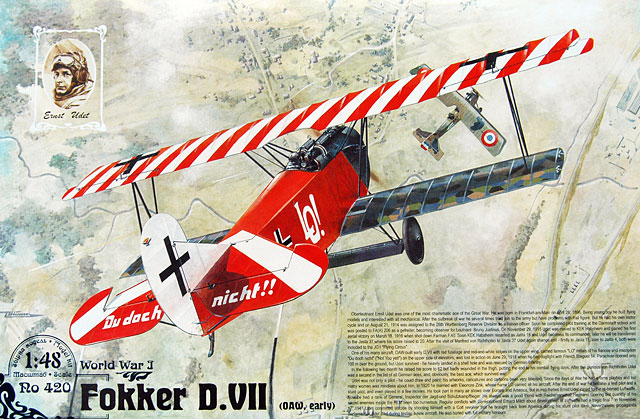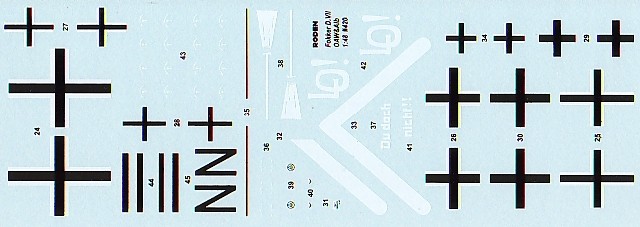|
Fokker D.VII
(OAW-early built)

Roden 1/48
S
u m m a r y
|
| Catalogue Number: |
Roden Fokker D.VII (OAW-early built)
Kit #420 |
| Scale: |
1/48 |
| Contents and Media: |
Six sprues in injection moulded
plastic; markings for three aircraft |
| Price: |
USD$15.96 from Squadron.com
|
| Review Type: |
FirstLook |
| Advantages: |
Accurate, well-researched, superb
attention to detail, option of an exposed engine. |
| Disadvantages: |
Blemishes on the lower wing trailing
edge. |
| Recommendation: |
Highly Recommended |
Reviewed by Robert Baumgartner

Roden's 1/48
scale Fokker D.VII (OEW-early built) may be ordered online from Squadron.com
Roden’s latest release in the Fokker D.VII family is the licence
built OAW version. The Ostdeutschen Albatros Werken made quite a few
changes to the pattern aircraft that they were lent, resulting in some
significant changes.
The kit represents an early build and as such the engine panels didn’t
have the multitude of louvers that later aircraft were to receive.
Instead we have covers with plain access doors as well as the one-piece
starboard top panel/radiator fairing.
All this appears on the new sprue F that also holds the appropriate
radiator with centrally mounted filler.

Click the thumbnails below
to view larger images:
Other sprues are more familiar except this time the modeler chooses
some of the alternate parts offered. There are 6 frames in total
providing 104 light grey parts.
Sprue V has the two types of engines, one Mercedes and the other BMW so
a spare is available for other projects. These still exhibit sharp
detail and the machine guns look as good as ever. The engine can be
displayed with the covers off but one must be careful to position it
correctly. There can be a tendency to locate it too low.
Remember not to install the interior framework if the covers are to
be kept on.
The usual cockpit items are to be placed between the fuselage halves and
Roden have supplied most of them. There is a lovely rendition of the
control column, complete with separate throttle levers, instrument
panel, compass, fuel pressure pump and rudder bar. A floor and seat are
also seen as is a rear fabric screen and fuel tank. A couple of extra
details can be added however, these being the second “throttle” and the
ignition control handle. Both were mounted on the port side.
A nice representation of the interior structure is found inside the
fuselage halves. None of this is detrimental to the outer surfaces as
there is not a sink mark in sight. When compared to the latest
information found in the Anthology series published by Albatros
Productions, the outlines matched perfectly.
Due to the thickness of the wings, Roden have moulded these in two
halves. As expected, the rib detail is wonderfully subtle as is the
representation of the leading edge ply sheathing. Care must be taken to
match up these halves, as the trailing edge scalloping on the bottom
wing is quite vague in places. A little filler should be used to match
up the upper bottom wing with its fully moulded counter part.
The ailerons have been provided as separate parts, along with the
elevators, and these really look good. A little care is needed with the
cleaning up of the hinge slots to ensure a proper fit. Cleverly the
control horns fit into slots in the ailerons to provide a very secure
attachment.
Stacking pads are present on the top wing but are surprisingly absent on
the lower ones. Some small sections of plastic rod will come in handy to
add these items.
Four sheets of decal are provided, two of which contain the upper and
lower four-colour lozenge, and another supplies the light blue rib
tapes. All sheets were in perfect register with a nice thin carrier
film.

Click the thumbnails below
to view larger images:
Three options are catered for; each chosen to reflect the early OAW
built D.VII:
Fokker D.VII (OAW), Jasta 4, 1918 flown by
Ernst Udet.
This controversial aircraft was an obvious choice for the kit as
it belonged to one of Germany’s best. He was their second highest
scoring ace and this is one of at least four machines that he flew.
Roden sensibly quote the source of the material used for the
colour scheme. In this case it is the well-reasoned discussion put
forward by Dave Roberts in the Fokker D.VII Anthology 2.
It was in this aircraft that Udet was “fooled” by an observer in a
French Breguet XIV.
Having apparently disabled the rear gunner with an attack from
behind, Udet flew to within point blank range to finish off the
aircraft. After seemingly feigning injury, the rear gunner sprang to
life and sprayed the unsuspecting Udet with machine gun fire. The
crippled German machine limped back to its own lines only to
suddenly plunge into a steep dive. After taking to his parachute,
Udet became snagged on the rudder. When he finally came free, his
chute opened with only a few meters to spare.
Fokker D.VII (OAW), 1918, pilot and Jasta
unknown
Unfortunately this machine remains unidentified. As such its
colours can only be speculated upon and Roden have chosen a light
grey front with dark green rear.
Fokker D.VII (OAW), Jasta 12, 1918 flown by
Ltn. d R Hans Besser.
Although Besser claimed 2 victories, he was just credited with 1.
His association with Jasta 12 wasn’t for very long as he only joined
in August 1918. The broom marking is a play on words regarding his
name and stood out well against the JG II blue fuselage.
No longer does the modeler have to chop and sand endlessly to convert a
generic D.VII into the version wanted.
With Roden bringing out their family of D.VIIs, life just got a whole
lot easier. The bonus of an engine to expose will please many and open
up a multitude of diorama possibilities.
Highly Recommended
Thanks to
Squadron.com for the review
sample.
Review and Images Copyright © 2004 by
Robert Baumgartner
Page Created 22 October, 2004
Last updated 22 October, 2004
Back to HyperScale Main Page
Back to Reviews Page
|
Home | What's
New | Features
| Gallery |
Reviews | Reference
| Forum
| Search